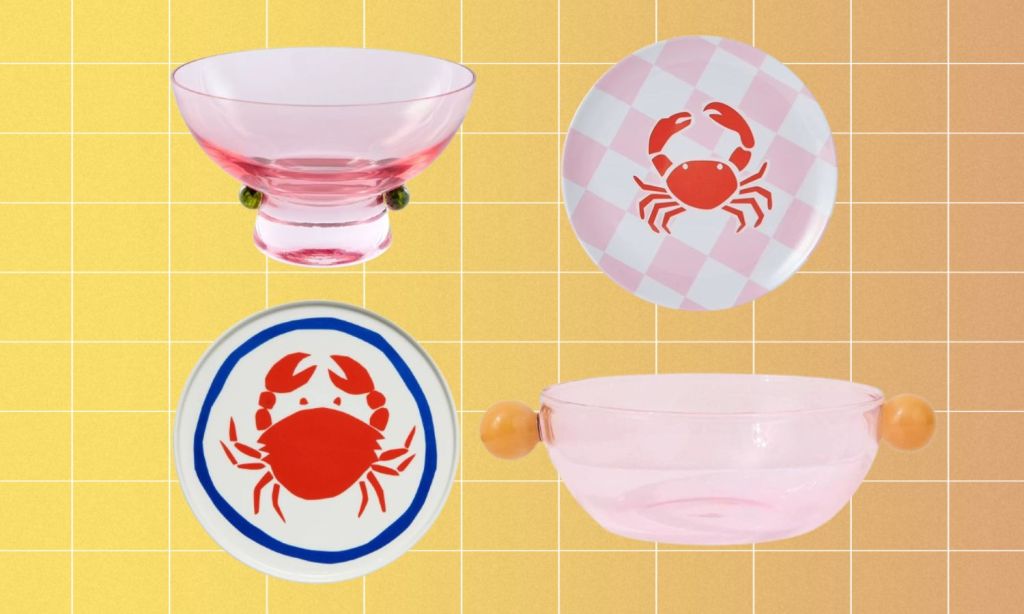Anyone interested in interiors knows about homewares dupes. They’re items undeniably like an original version but are often made with cheaper materials and always sold for a fraction of the price.
Kmart, in particular, is known for its homewares dupes, most recently selling dinnerware strikingly similar to that of Australian designer brands In The Roundhouse, Maison Balzac and McMullin and Co., with some pieces going for as little as $2.
Kmart’s pink pedestal bowl features two glass beads on its sides is a dupe for Maison Balzac’s Dot Dot Bowl. The bowl is now available online for $2, while the Dot Dot Bowl range was $39-$69.
The discount retailer is also selling plastic side plates with crab artwork similar to that on one of In The Roundhouse’s. The brand co-founded by Brooke Bickmore and Alyce Tran had collaborated with Sydney-based artist Daimon Downey on the plate, part of their Seafood collection.
“Our reaction was that we needed to pivot and keep innovating to keep our customers feeling as though they are buying into an elevated brand and unique product,” Tran says.
Alice McMullin, founder of McMullin and Co., says she understands the place in the market for dupes. They’re an option for people who don’t have the budget for the original.
“However, as a designer myself, it is heartbreaking to see a copy of a product you have worked so hard on,” says McMullin. “I now see imitation as the highest form of flattery and know it’s time to stop producing a product, as hard as it is, when it becomes trendy. It’s the stage before tacky.”
Elise Pioch Chappell (née Balzac), founder of Maison Balzac, says she hadn’t seen the Kmart dupe of the Dot Dot Bowl until asked about it for this story. She admits she can see why it’s being called a dupe for her original.
“However, it’s obvious that the quality of the glass, the colour and the proportions are all wrong,” she says. “I don’t feel bad about it because it looks like a poor, vague inspiration of a Maison Balzac style.”
In a blog post for Australian fashion and homewares store Incu, Pioch Chappell says the process of producing Maison Balzac glassware starts with a dream, an idea or an object she used to see at home as a child.
“I make a drawing and suggest colours to produce the first samples,” she says. “Our glass master creates a prototype, sends it to us, and we live with it in the studio for a while before we decide if it can become part of the collection.”
She says she thinks it’s appalling when brands copy exactly an existing product, calling it pure laziness. When you buy the original idea, she says you are sure to keep it for longer.
“It is false economy to think that buying it cheaper is a saving because you will have to buy it again in 3 to 6 months,” she says. “Original products end up being cheaper in the long term.”
Tran and McMullin agree — the quality, the originality and how the pieces will last you more than a season are the main reasons for buying the original product. In her eyes, dupes cross the line when they are straight-out copies.
“I always have the attitude ‘I am too poor to afford rubbish quality as it never lasts long, and you have to keep rebuying’,” says McMullin.
When an original, artist’s work design is copyrighted in Australia, the copyright protection generally lasts for the author’s lifetime plus 70 years. Copyright is infringed if there is direct or indirect copying of a “substantial part” of the artistic work in which copyright subsists. The way many dupe makers get around these copyright restrictions is that they replicate less than that illegal “substantial part”.
“To be clear, we don’t think the large retailers have directly copied our product, but rather have been inspired,” Tran says. “It would be great if dupe makers paid design fees or collaborated with original designers a little more.”
Pioch Chappell says she’d like to see the dupe makers contacting the designers to see if the two parties could work together on capsule collections. Apart from that, she thinks designers should continue to express their taste, produce innovative ideas and not even look at copies.
“In the meantime, dupe makers should use their talents to come up with affordable collections based on worldwide trends, not particular products,” she says. “Integrity is key in this world. They should try it – I am sure they would feel so much better about themselves.”
We’ve reached out to Kmart to comment and will update this story with their response.
Related: The Buzziest Homewares Stores to Seek Out in Bali
Related: The Scandi Homewares Brands You’re Seeing Everywhere (and No, They’re Not Ikea)
Read more stories from The Latch and subscribe to our email newsletter.

